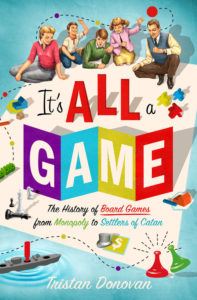by Tristan Donovan
In the early 1950s Albert Lamorisse, who would later win an Academy Award for his 1956 film The Red Balloon, devised a war game called La Conquête du Monde, or the Conquest of the World, during a family vacation. As the name suggests, the goal was world domination, and it had players waging war with Napoleonic armies and navies across the globe until only one remained.

Unlike Avalon Hill’s more mathematically minded efforts, Lamorisse’s game distilled the battles for each slice of territory down to a contest of dice rolls. With each roll of the dice, the player with the lowest score lost a unit and this continued until one side was eliminated.
After applying for a patent in March 1954, Lamorisse sold La Conquête du Monde to the French game publisher Miro, which asked game designer and philosophy teacher Jean-René Vernes to improve it. Vernes removed the naval vessels and reformed the combat so that it favored defending players. Now players would get one die for each army they sent into battle up to a maximum of three, and if they rolled the same number as the defending player they would lose one of their attacking armies.
Revisions made, La Conquête du Monde went on sale in France in 1957. Soon after, Miro showed the game to the U.S. game giant Parker Brothers, who jumped at the chance to release it in North America.

Despite snapping up the rights, Parker Brothers felt Verne’s improvements did not go far enough. The main problem was that the game took ages to play as troops chipped away at entrenched defenders over and over again. To fix the problem Parker Brothers tipped the balance of combat in favor of the attackers by limiting defenders to using no more than two dice in combat. Problem solved, they renamed the game Risk and launched it in 1959.
Many within Parker Brothers were uneasy about Risk. Sales of war toys were in decline as parents turned against the idea of arming children with plastic guns and the other pretend paraphernalia of warfare. The company feared that Risk would also be a victim of this parental backlash. Price was also a concern. Most board games cost around two dollars but Risk cost seven and a half, thanks to its large board and the heaps of colored wooden pieces that formed the in-game troops.
Yet instead of scaring off customers with Risk’s price and military theme, Risk became one of the hottest games of the year with more than 100,000 copies sold in its launch year. In the years that followed Risk sold millions, becoming not only the most popular war game ever devised, but one of the most popular board games of all time.
Committed war gamers with lifetime subscriptions to The General might have sneered at the simplistic combat and lack of realism but their preferred games couldn’t match the immediacy of Risk. “From the very first move it’s competitive,” says Philip E. Orbanes, who founded war-game publisher Gamescience in 1965. “You’re butting up against somebody and you’re attacking them or they are attacking you. It’s not like you sit back and patiently build your army—it’s instant action from the beginning and that’s one of its great merits.”
 And thanks to its mass appeal, Risk continued to thrive even as tabletop war gaming slipped into seemingly terminal decline in the late 1970s.
And thanks to its mass appeal, Risk continued to thrive even as tabletop war gaming slipped into seemingly terminal decline in the late 1970s.
The first blow to war gaming came from a monster of its own making: Dungeons & Dragons. First published in 1974, Dungeons & Dragons was created by war-game designers Dave Arenson and Gary Gygax.
A few years earlier Gygax had co-developed a medieval-era war game called Chainmail that included fantasy elements such as magic. Chainmail went down well with war gamers, but it was clear that it was the fantasy and not the medieval warfare that was winning them over. Gygax and Arenson responded by making a pure fantasy game that transferred the dice and probability combat systems of war games into a setting inspired by J.R.R. Tolkien’s The Lord of the Rings.
The result was Dungeons & Dragons, the first role-playing game. In Dungeons & Dragons players took on the persona of wizards, warriors, and other heroes and went on epic quests set up and managed by a dungeon master, who acted much like the umpires of Kriegsspiel games.
But unlike the war games that inspired it, Dungeons & Dragons did not require a board. Instead it relied on players’ imaginations. Aided by the storytelling of the dungeon master, players would act out their adventurers’ lives and use dice to determine the outcomes of decisions and battles with fearsome monsters. Dungeons & Dragons became a phenomenon and spawned countless other role-playing games from the cyberpunk adventures of Shadowrun to the gothic horror of Vampire: The Masquerade.
By 1979 more than a quarter million Dungeons & Dragons rulebooks had been sold, and many of those who bought them might once have found themselves playing general in a war game rather than role-playing an orc-slaying elf.
TRISTAN DONOVAN is a British author and journalist. His books include It’s All a Game and his writing has appeared in numerous publications, including BBC News Online, The Atlantic, The Times of London, Stuff, Wired, The Guardian, Eurogamer, Kotaku,Community Care, and The Big Issue. He lives in the UK.
